Flood Hazard Assessment and Monitoring in Bangladesh: An Integrated Approach for Disaster Risk Mitigation
Abstract
1. Introduction
- What is the spatial-temporal pattern of the flooded area in Bangladesh?
- What is the extent of damage from the flood?
- What system can identify near-real-time floods?
2. Materials and Methods
2.1. Study Area
2.2. Data
2.3. Flood Extent Map
2.4. Damage Assessment
2.5. Near Real-Time Flood Monitoring
3. Results
4. Discussion
5. Conclusions
Author Contributions
Funding
Data Availability Statement
Conflicts of Interest
Abbreviations
| EM-DAT | The International Disaster Database |
| ESA | European Space Agency |
| GDP | Gross Domestic Product |
| GEE | Google Earth Engine |
| GHSL | GEE database’s global settlement characteristics |
| GMB | Ganges-Brahmaputra-Meghna |
| GNSS-R | Global Navigation Satellite System Reflectometry |
| IRI | International roughness index |
| IW | Interferometric wide swath |
| MODIS | Moderate Resolution Imaging Spectroradiometer |
| NH | National Highways |
| NRT | Near-Real-Time |
| RHD | Roads & Highways Department |
| RS | Remote Sensing |
| SAR | Synthetic Aperture Radar |
| USD | The United States Dollar |
References
- Jun, R.; Melda, S.; Arga, J. Flood Risk Already Affects 1.81 Billion People. Climate Change and Unplanned Urbanization Could Worsen Exposure. Available online: https://blogs.worldbank.org/en/climatechange/flood-risk-already-affects-181-billion-people-climate-change-and-unplanned (accessed on 26 November 2024).
- World Economic Forum. Sea Level Rise Is a GlobalThreat—Here’s Why|World Economic Forum. Available online: https://www.weforum.org/stories/2024/09/rising-sea-levels-global-threat/ (accessed on 26 November 2024).
- United Nations Development Program (UNDP). Climate Change’s Impact on Coastal Flooding to Increase 5 Times over This Century, Putting over 70 Million People in the Path of Expanding Floodplains, According to New UNDP and CIL Data|United Nations Development Program. Available online: https://www.undp.org/press-releases/climate-changes-impact-coastal-flooding-increase-5-times-over-century-putting-over-70-million-people-path-expanding-floodplains (accessed on 26 November 2024).
- Salas, R.B. Global Economic Loss from Natural Disasters 2023|Statista. Available online: https://www.statista.com/statistics/510922/natural-disasters-globally-and-economic-losses-by-peril/ (accessed on 26 November 2024).
- Decadal Average: Annual Number of Deaths from Disasters, World. Available online: https://ourworldindata.org/grapher/decadal-deaths-disasters-type (accessed on 26 November 2024).
- Osti, R.; Tanaka, S.; Tokioka, T. Flood Hazard Mapping in Developing Countries: Problems and Prospects. Disaster Prev. Manag. Int. J. 2008, 17, 104–113. [Google Scholar] [CrossRef]
- Rana, S.M.S.; Habib, S.A.; Sharifee, M.N.H.; Sultana, N.; Rahman, S.H. Flood Risk Mapping of the Flood-Prone Rangpur Division of Bangladesh Using Remote Sensing and Multi-Criteria Analysis. Nat. Hazards Res. 2024, 4, 20–31. [Google Scholar] [CrossRef]
- BWDB 2021 Annual Flood Report, Flood Forecasting and Warning Centre, Processing and Flood Forecasting Circle; Bangladesh Water Development Board: Dhaka, Bangladesh, 2020.
- Kabir, H.; Hossen, N. Impacts of Flood and Its Possible Solution in Bangladesh. Disaster Adv. 2019, 12, 48–57. [Google Scholar]
- Sultana, M.; Chai, G.; Martin, T.; Chowdhury, S. Modeling the Post flood Short-Term Behavior of Flexible Pavements. J. Transp. Eng. 2016, 142, 04016042. [Google Scholar] [CrossRef]
- Baten, A.; González, P.A.; Delgado, R.C. Natural Disasters and Management Systems of Bangladesh from 1972 to 2017: Special Focus on Flood. OmniSci. Multi-Discip. J. 2019, 8, 35–47. [Google Scholar]
- Ministry of Environment Forest and Climate Change (MoEF). National Adaptation Plan of Bangladesh; Ministry of Environment, Forestry and Climate Change: Dhaka, Bangladesh, 2022. [Google Scholar]
- Amin, M.S.R.; Tamima, U.; Amador, L. Towards Resilient Roads to Storm-Surge Flooding: Case Study of Bangladesh. Int. J. Pavement Eng. 2018, 21, 63–73. [Google Scholar] [CrossRef]
- Rahaman, M.O.; Mostafa, T.; Mamun, M.A.A. Scarcity of Road Construction Materials in Bangladesh: Exploring Pavement Recycling Option as a Solution. Int. J. Struct. Civ. Eng. Res. 2020, 9, 25–33. [Google Scholar] [CrossRef]
- Elshaer, M.; Daniel, J.S. Impact of Pavement Layer Properties on the Structural Performance of Inundated Flexible Pavements. Transp. Geotech. 2018, 16, 11–20. [Google Scholar] [CrossRef]
- Alam, M.J.B.; Zakaria, M. Design and Construction of Roads in Flood-Affected Areas. Eng. Concerns Flood 2008, 99, 91–99. [Google Scholar]
- United Nations Economic and Social Commission for Asia and the Pacific (UNESCAP). Sustainable Freight Transport in Bangladesh; United Nations. 2022. Available online: https://repository.unescap.org/bitstream/handle/20.500.12870/5167/ESCAP-2022-RP-Sustainable-Freight-Transport-in-Bangladesh.pdf (accessed on 20 March 2025).
- Hossen, N.; Nawaz, S.; Kabir, H. Flood Research in Bangladesh and Future Direction: An Insight From Last Three Decades. Int. J. Disaster Risk Manag. 2022, 4, 15–39. [Google Scholar] [CrossRef]
- World Bank. The Cost of Adapting to Extreme Weather Events in a Changing Climate; BANGLADESH Development Series; World Bank: Washington, DC, USA, 2011; pp. 1–21. [Google Scholar]
- Ullah, K.; Id, J.Z. GIS-Based Flood Hazard Mapping Using Relative Frequency Ratio Method: A Case Study of Panjkora River Basin, Eastern Hindu Kush. PLoS ONE 2020, 15, e0229153. [Google Scholar] [CrossRef]
- Tai, C.V.; Dinh, Q.N.; Ho, T.S.; Viet, N.T. Rapid Assessment of Flood Extent and Damages in Quang Nam Province by Using Sentinel-1 Data Rapid Assessment of Flood Extent and Damages in Quang Nam Province by Using Sentinel-1 Data. 2021. Available online: https://tailieuso.tlu.edu.vn/handle/DHTL/10996 (accessed on 20 March 2025).
- Uddin, K.; Matin, M.A. Potential Flood Hazard Zonation and Flood Shelter Suitability Mapping for Disaster Risk Mitigation in Bangladesh Using Geospatial Technology. Prog. Disaster Sci. 2021, 11, 100185. [Google Scholar] [CrossRef]
- Uddin, K.; Matin, M. Rapid Flood Mapping Using Multi-Temporal SAR Images: An Example from Bangladesh. In Earth Observation Science and Applications for Risk Reduction and Enhanced Resilience in Hindu Kush Himalaya Region; Springer: Cham, Switzerland, 2021; Chapter 10. [Google Scholar] [CrossRef]
- Haque, S.; Ikeuchi, K.; Shrestha, B.B.; Kawasaki, A.; Minamide, M. Establishment of Flood Damage Function Model for Rural Roads: A Case Study in the Teesta River Basin, Bangladesh. Prog. Disaster Sci. 2023, 17, 100269. [Google Scholar] [CrossRef]
- Rahman, M.M.; Kamruzzaman, M.; Deb, L.; Islam, H.M.T. Flood Mapping, Damage Assessment, and Susceptibility Zonation in Northeastern Bangladesh in 2022 Using Geospatial Datasets. Prog. Disaster Sci. 2025, 25, 100402. [Google Scholar] [CrossRef]
- Tripathi, G.; Parida, B.R.; Pandey, A.C. Spatio-Temporal Rainfall Variability and Flood Prognosis Analysis Using Satellite Data over North Bihar during the August 2017 Flood Event. Hydrology 2019, 6, 38. [Google Scholar] [CrossRef]
- Unnithan, S.L.K.; Biswal, B.; Rüdiger, C.; Dubey, A.K. A Novel Conceptual Flood Inundation Model for Large-Scale Data-Scarce Regions. Environ. Model. Softw. 2024, 171, 105863. [Google Scholar] [CrossRef]
- Yan, K.; Di Baldassarre, G.; Solomatine, D.P.; Schumann, G.J.-P. A Review of Low-cost Space-borne Data for Flood Modelling: Topography, Flood Extent and Water Level. Hydrol. Process. 2015, 29, 3368–3387. [Google Scholar] [CrossRef]
- Gord, S.; Hafezparast Mavaddat, M.; Ghobadian, R. Flood Impact Assessment on Agricultural and Municipal Areas Using Sentinel-1 and 2 Satellite Images (Case Study: Kermanshah Province). Nat. Hazards 2024, 120, 8437–8457. [Google Scholar] [CrossRef]
- Huang, M.; Jin, S. Rapid Flood Mapping and Evaluation with a Supervised Classifier and Change Detection in Shouguang Using Sentinel-1 SAR and Sentinel-2 Optical Data. Remote Sens. 2020, 12, 2073. [Google Scholar] [CrossRef]
- Dhanabalan, S.P.; Rahaman, S.A.; Jegankumar, R. Flood Monitoring Using Sentinel-1 Sar Data: A Case Study Based on an Event of 2018 and 2019 Southern Part of Kerala. Int. Arch. Photogramm. Remote Sens. Spat. Inf. Sci.—ISPRS Arch. 2021, 44, 37–41. [Google Scholar] [CrossRef]
- Uddin, K.; Matin, M.A.; Meyer, F.J. Operational Flood Mapping Using Multi-Temporal Sentinel-1 SAR Images: A Case Study from Bangladesh. Remote Sens. 2019, 11, 1581. [Google Scholar] [CrossRef]
- Singha, M.; Dong, J.; Sarmah, S.; You, N.; Zhou, Y.; Zhang, G.; Doughty, R.; Xiao, X. Identifying Floods and Flood-Affected Paddy Rice Fields in Bangladesh Based on Sentinel-1 Imagery and Google Earth Engine. ISPRS J. Photogramm. Remote Sens. 2020, 166, 278–293. [Google Scholar] [CrossRef]
- Tazmul Islam, M.; Meng, Q. An Exploratory Study of Sentinel-1 SAR for Rapid Urban Flood Mapping on Google Earth Engine. Int. J. Appl. Earth Obs. Geoinf. 2022, 113, 103002. [Google Scholar] [CrossRef]
- Singh, G.; Rawat, K.S. Mapping Flooded Areas Utilizing Google Earth Engine and Open SAR Data: A Comprehensive Approach for Disaster Response. Discov. Geosci. 2024, 2, 5. [Google Scholar] [CrossRef]
- Worldometer Bangladesh Population. Worldometer. 2024. Available online: https://www.worldometers.info/world-population/bangladesh-population/ (accessed on 22 November 2024).
- World Bank Bangladesh—Climatology|Climate Change Knowledge Portal. Available online: https://climateknowledgeportal.worldbank.org/country/bangladesh/climate-data-historical (accessed on 22 November 2024).
- Japan International Cooperation Agency (JICA). Data Collection Survey on Disaster Risk Reduction; Japan International Cooperation Agency: Tokyo, Japan, 2017; Volume 2, p. 245. [Google Scholar]
- Potin, P.; Rosich, B.; Miranda, N.; Grimont, P. Sentinel-1 Mission Status. Procedia Comput. Sci. 2016, 100, 1297–1304. [Google Scholar] [CrossRef]
- European Space Agency (ESA). S1 Applications. Available online: https://sentiwiki.copernicus.eu/web/s1-applications (accessed on 23 November 2024).
- Tarpanelli, A.; Mondini, A.C.; Camici, S. Effectiveness of Sentinel-1 and Sentinel-2 for Flood Detection Assessment in Europe. Nat. Hazards Earth Syst. Sci. 2022, 22, 2473–2489. [Google Scholar] [CrossRef]
- EM-DAT—The International Disaster Database. Available online: https://www.emdat.be/ (accessed on 1 December 2024).
- Kang, Y.; Pan, L.; Chen, Q.; Zhang, T.; Zhang, S.; Liu, Z. Automatic Mosaicking of Satellite Imagery Considering the Clouds. ISPRS Ann. Photogramm. Remote Sens. Spat. Inf. Sci. 2016, III–3, 415–421. [Google Scholar] [CrossRef]
- Portalés-Julià, E.; Mateo-García, G.; Purcell, C.; Gómez-Chova, L. Global Flood Extent Segmentation in Optical Satellite Images. Sci. Rep. 2023, 13, 20316. [Google Scholar] [CrossRef]
- Haghighi, M.H. Large-Scale Mapping of Flood Using Sentinel-1 Radar Remote Sensing. Int. Arch. Photogramm. Remote Sens. Spat. Inf. Sci. 2022, XLIII-B3-2022, 1097–1102. [Google Scholar] [CrossRef]
- United Nations. Step-by-Step: Recommended Practice: Flood Mapping and Damage Assessment Using Sentinel-1 SAR Data in Google Earth Engine|UN-SPIDER Knowledge Portal. Available online: https://www.un-spider.org/advisory-support/recommended-practices/recommended-practice-google-earth-engine-flood-mapping/step-by-step (accessed on 24 November 2024).
- Rahman, M.; Ningsheng, C.; Islam, M.M.; Dewan, A.; Iqbal, J.; Washakh, R.M.A.; Shufeng, T. Flood Susceptibility Assessment in Bangladesh Using Machine Learning and Multi-Criteria Decision Analysis. Earth Syst. Environ. 2019, 3, 585–601. [Google Scholar] [CrossRef]
- iFarmer: The Tech-Enabled One-Stop Solution for Smallholder Farmers | The Daily Star. Available online: https://www.thedailystar.net/supplements/accelerating-bangladesh/news/ifarmer-the-tech-enabled-one-stop-solution-smallholder-farmers-3263131 (accessed on 3 December 2024).
- Dewan, A.M.; Alam, M.; Nishigaki, M. Remote Sensing of 1998 and 2000 Floods in Greater Dhaka, Bangladesh: Experiences from Catastrophic and Normal Events. J. Fac. Environ. Sci. Technol. 2005, 10, 57–65. [Google Scholar]
- Adhikary, T.S. Over 1,000 km Roads Damaged by Flood. Available online: https://www.thedailystar.net/frontpage/news/over-1000km-roads-damaged-flood-1787584 (accessed on 7 February 2021).
- Roads & Highways Department (RHD). Road Master Plan; Roads & Highways Department (RHD): Dhaka, Bangladesh, 2009. [Google Scholar]
- Ministry of Road Transport & Bridges (MoRTB). Bangladesh Highway Act, 2021; Bangladesh National Parliament, Bangladesh: Dhaka, Bangladesh, 2021. [Google Scholar]
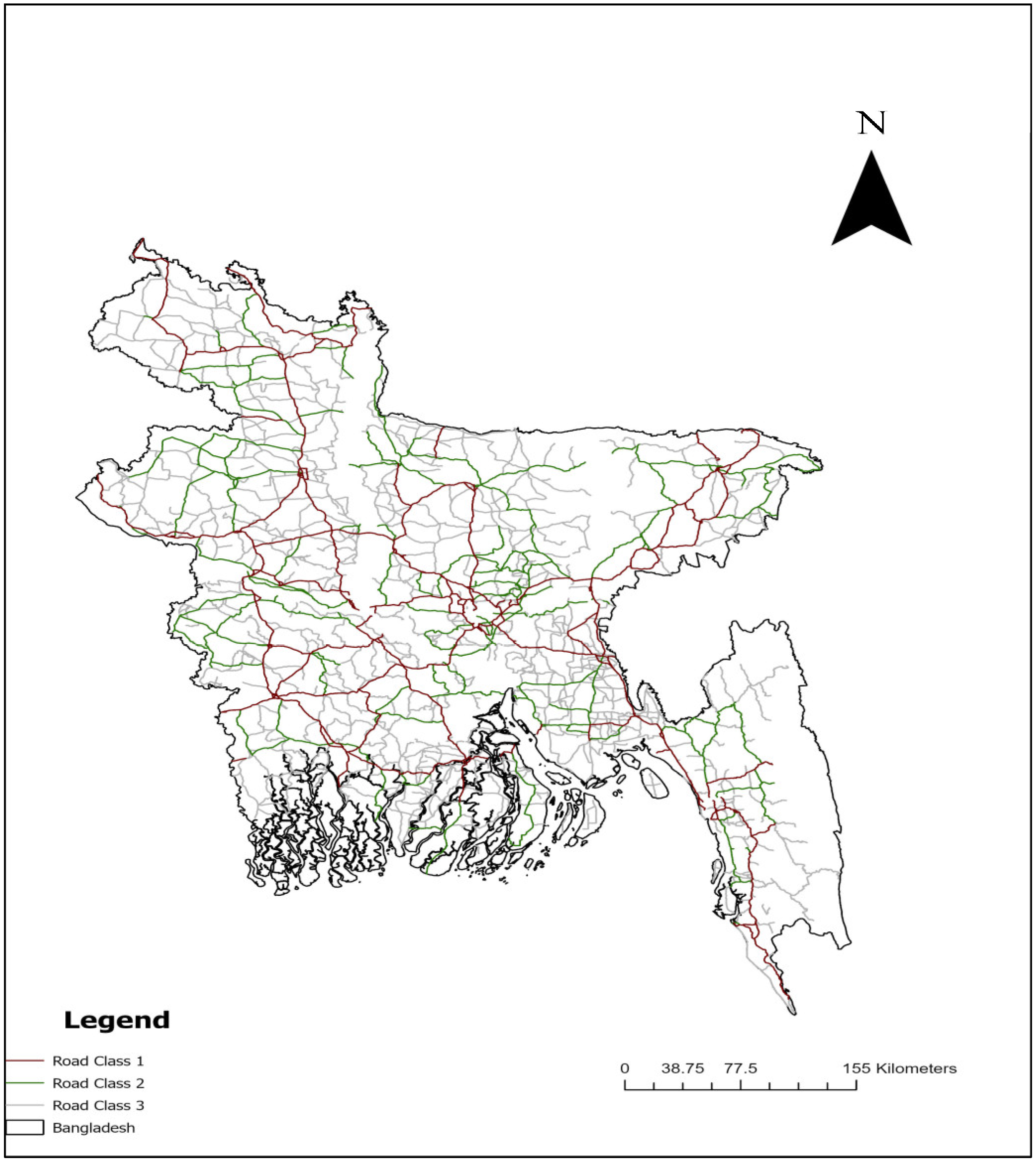
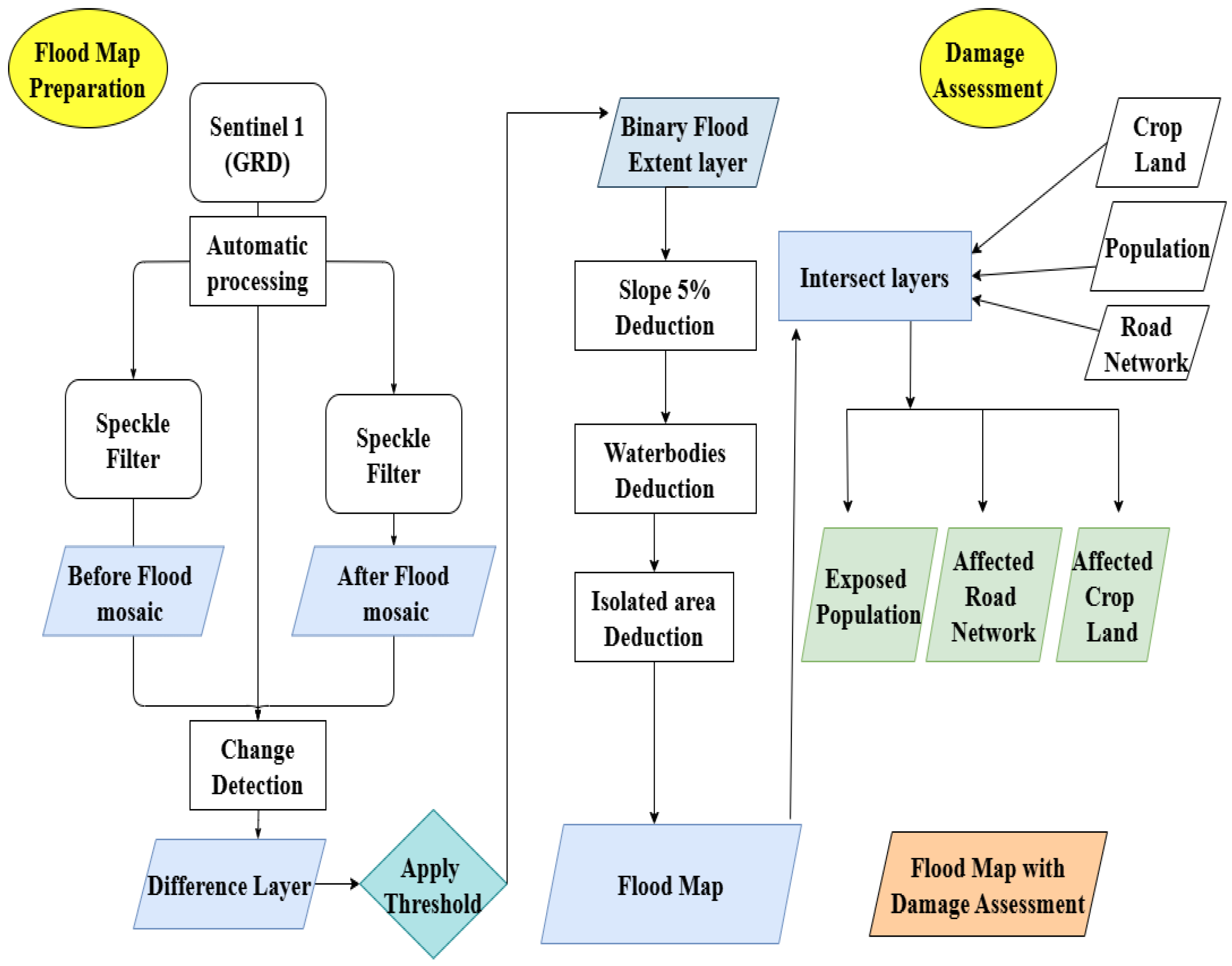
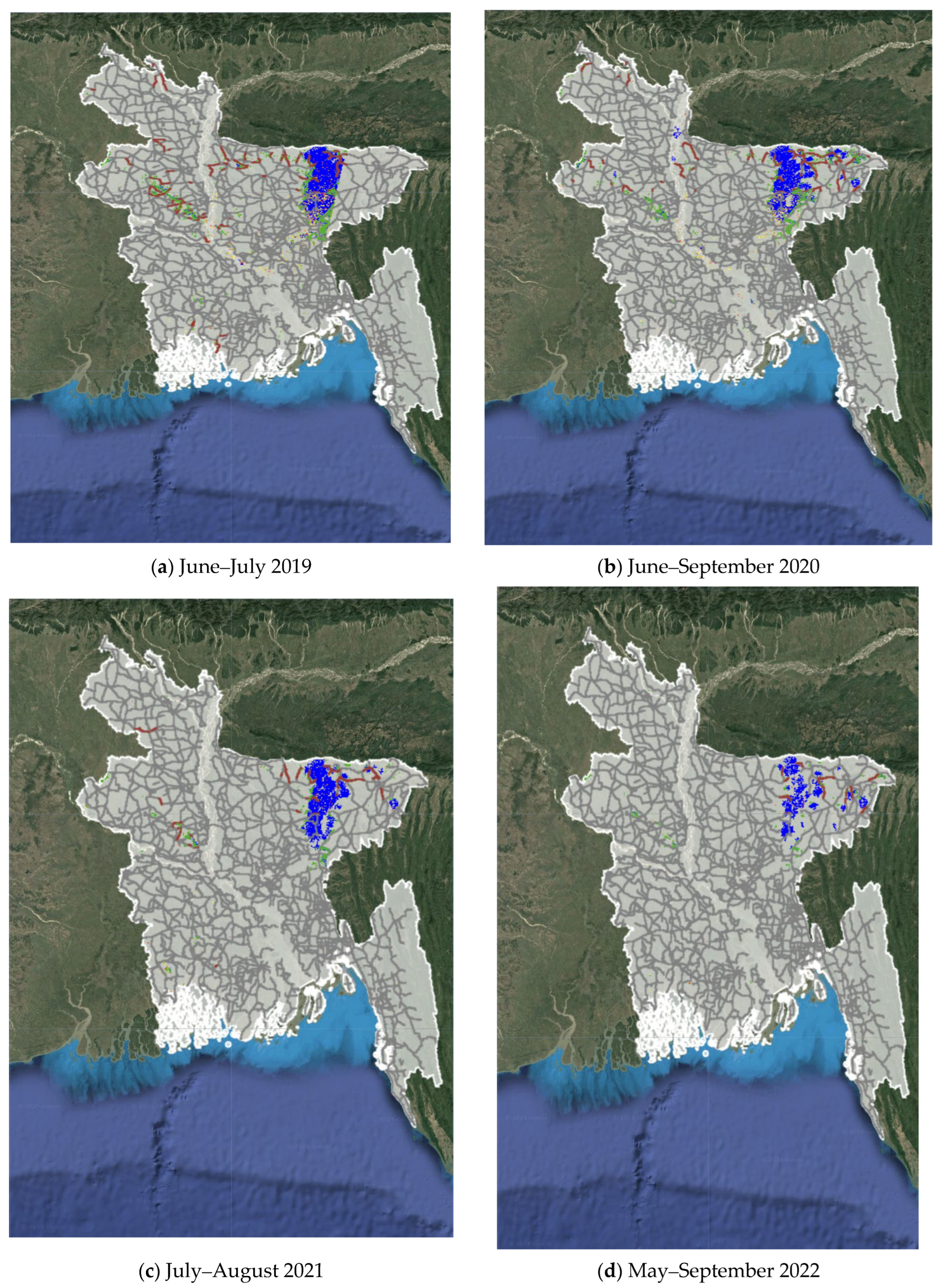
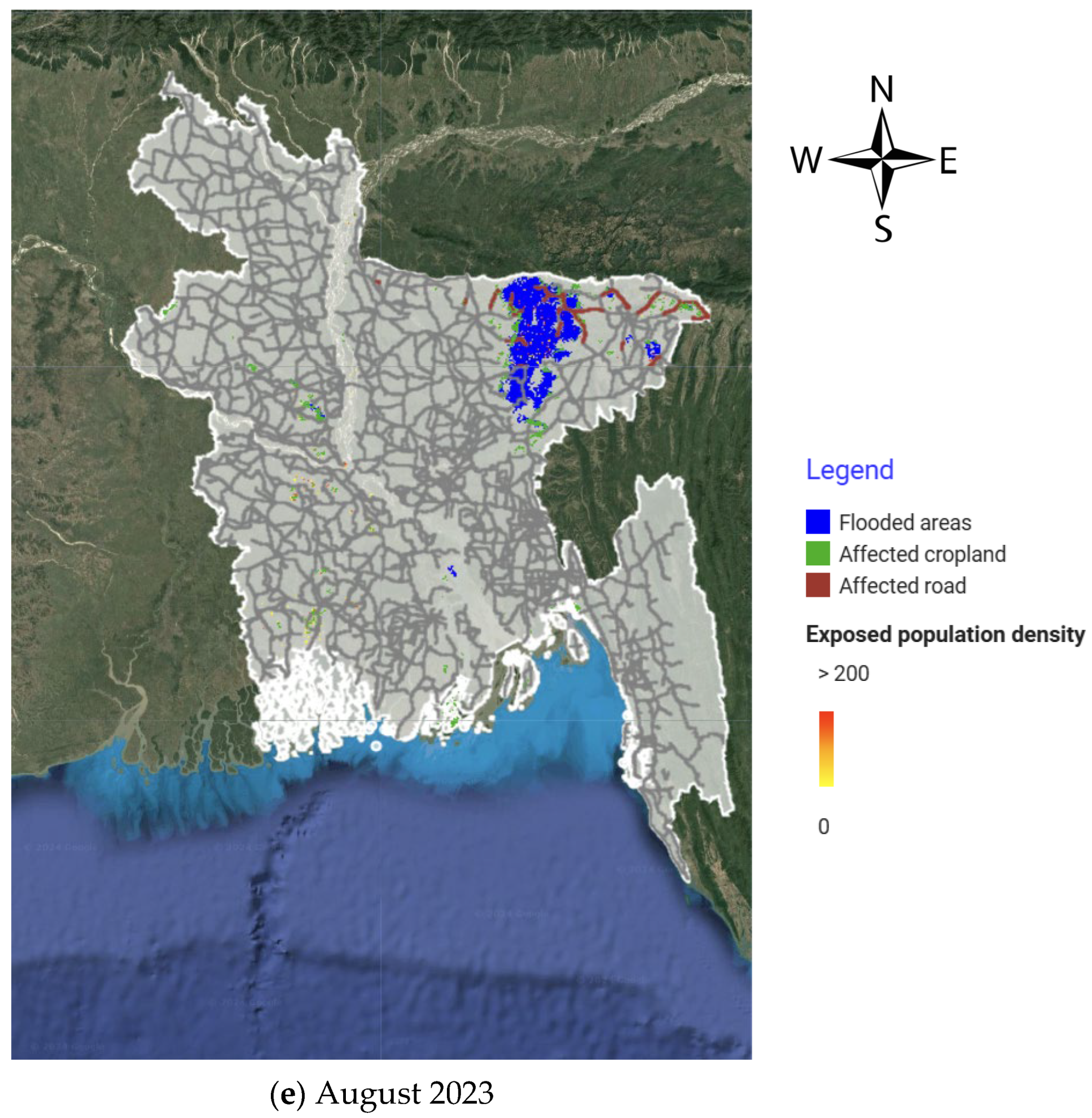
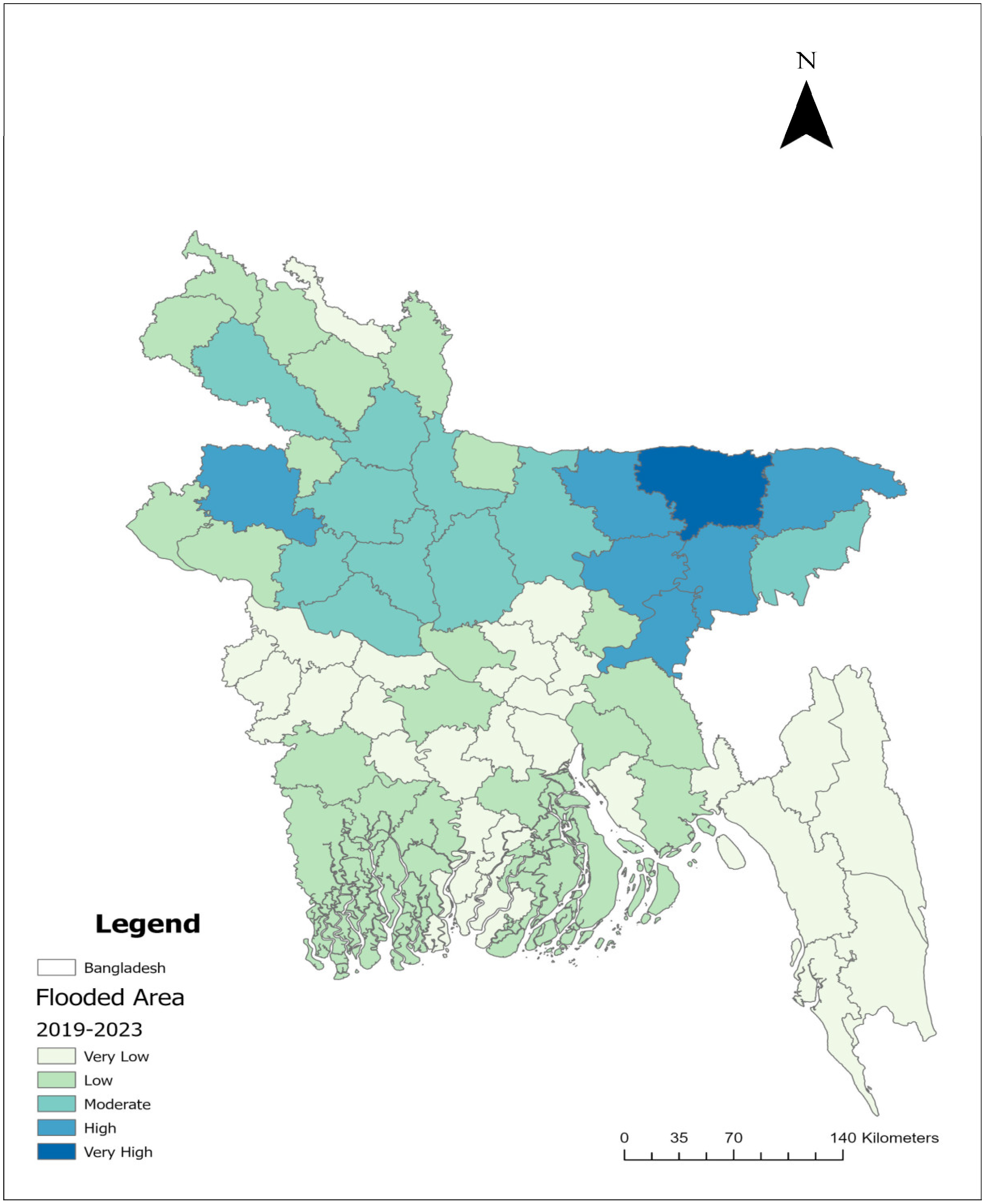
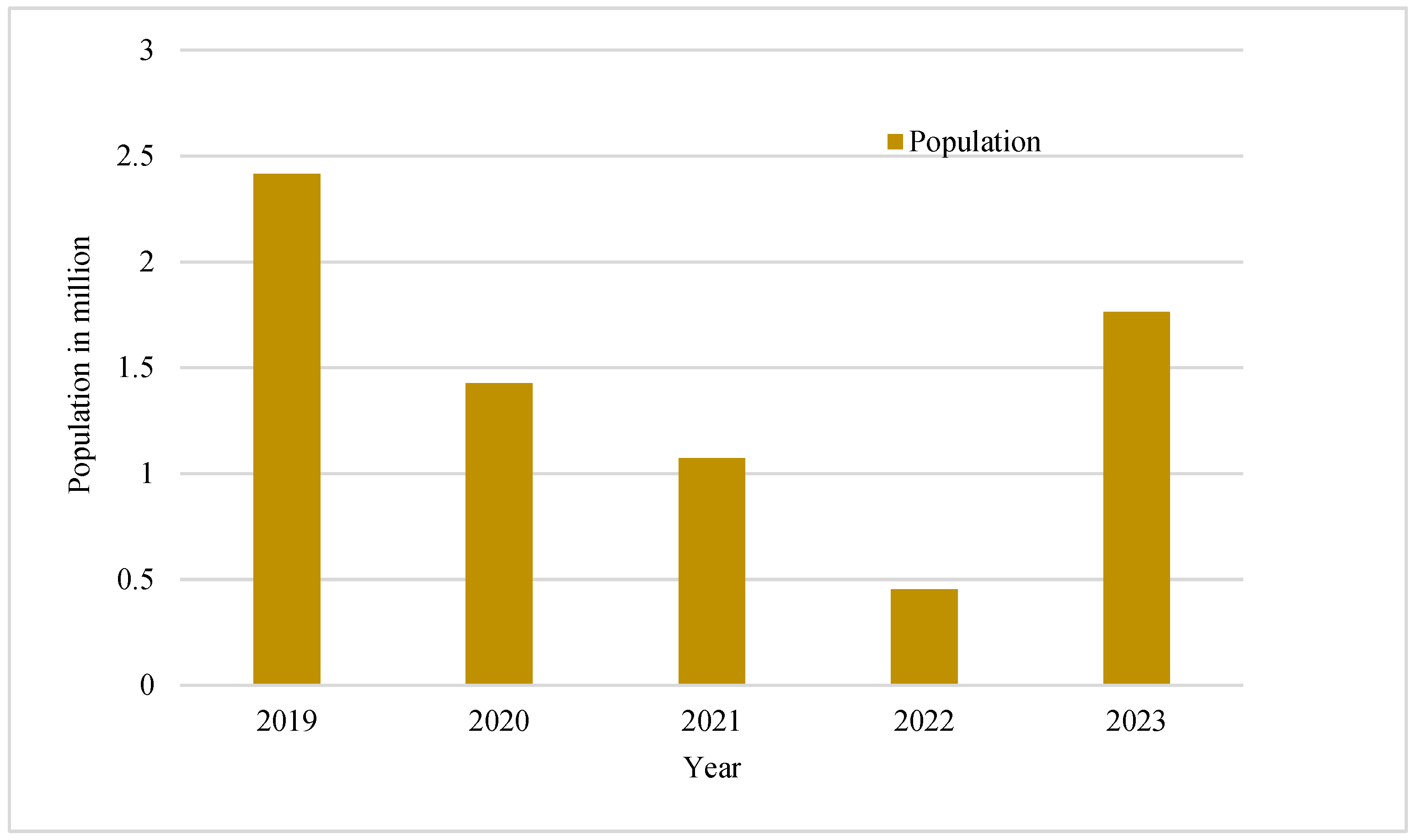
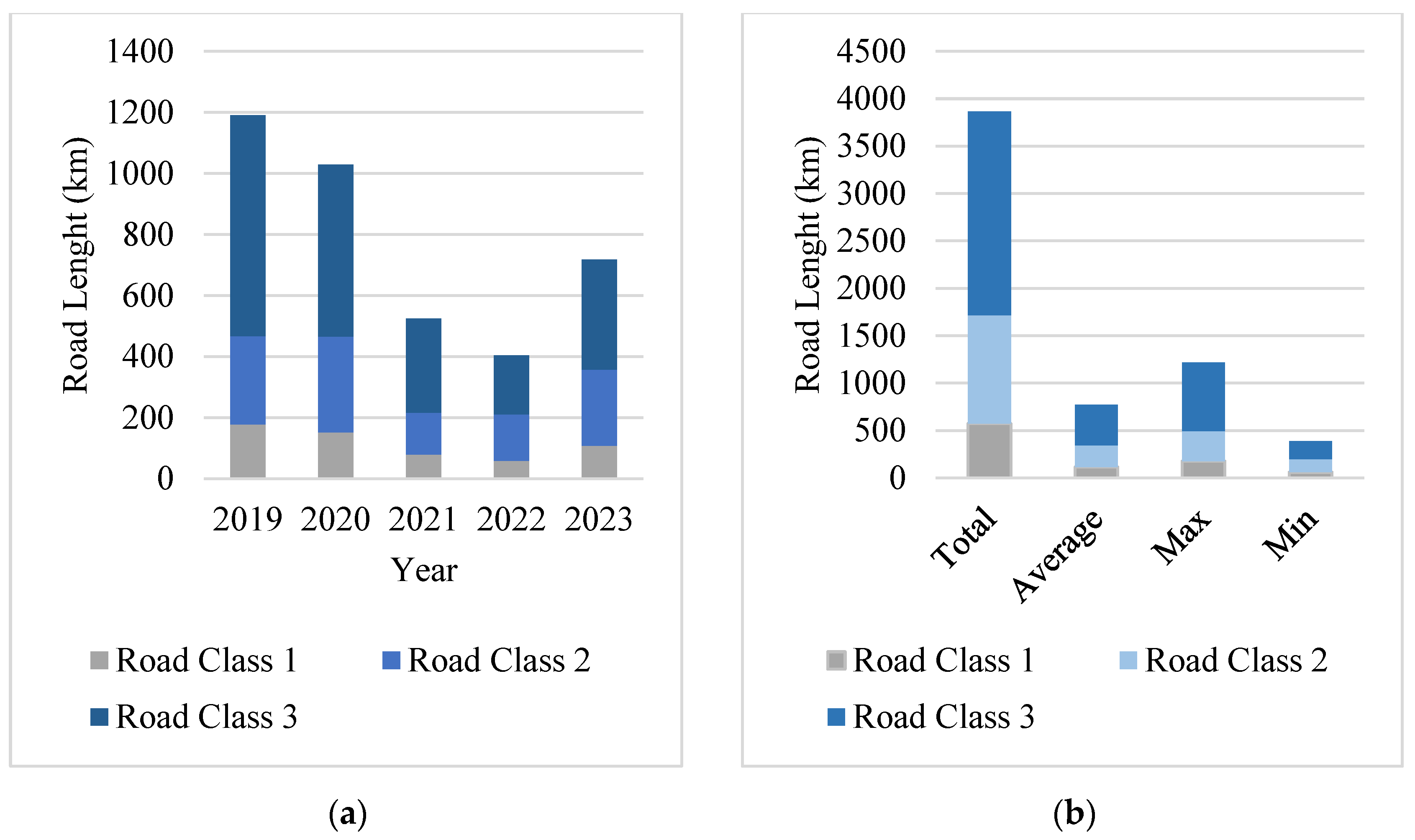
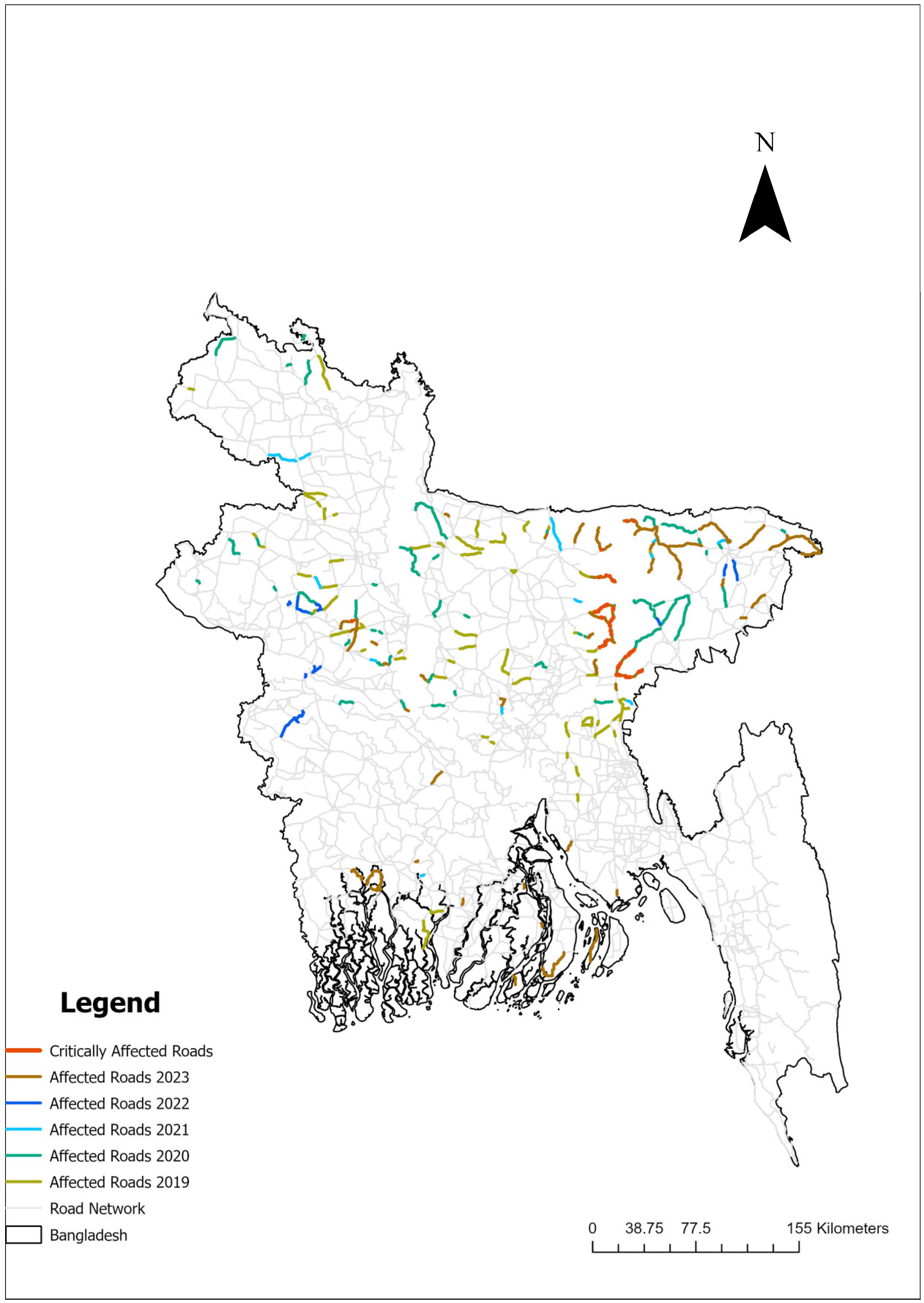
| Division/Year | 2019 | 2020 | 2021 | 2022 | 2023 |
|---|---|---|---|---|---|
| Sylhet | 209,573 | 360,033 | 238,719 | 212,659 | 273,040 |
| 16.59% | 28.49% | 18.89% | 16.83% | 21.61% | |
| Dhaka- Mymensingh | 306,356 | 243,302 | 171,003 | 112,029 | 185,036 |
| 9.83% | 7.80% | 5.48% | 3.59% | 5.93% | |
| Rajshahi | 139,891 | 110,094 | 44,850 | 30,372 | 45,993 |
| 7.71% | 6.06% | 2.47% | 1.67% | 2.53% | |
| Rangpur | 22,874 | 34,299 | 8758 | 3274 | 9728 |
| 1.41% | 2.12% | 0.54% | 0.20% | 0.60% | |
| Chattogram | 79,399 | 54,408 | 34,240 | 19,023 | 42,162 |
| 2.34% | 1.60% | 1.01% | 0.56% | 1.24% | |
| Others | 47,997 | 32,659 | 36,304 | 13,514 | 65,975 |
| 1.35% | 0.92% | 1.02% | 0.38% | 1.86% | |
| Total Affected Area | 806,091 | 834,796 | 533,876 | 390,872 | 621,934 |
| 5.46% | 5.66% | 3.62% | 2.65% | 4.21% |
| Division/Year | 2019 | 2020 | 2021 | 2022 | 2023 |
|---|---|---|---|---|---|
| Sylhet | 23,188 | 81,025 | 16,238 | 16,651 | 34,119 |
| 1.84% | 6.41% | 1.29% | 1.32% | 2.70% | |
| Dhaka- Mymensingh | 59,811 | 26,385 | 14,396 | 3242 | 21,051 |
| 1.92% | 0.85% | 0.46% | 0.10% | 0.68% | |
| Rajshahi | 57,501 | 42,917 | 19,101 | 12,662 | 18,338 |
| 3.17% | 2.36% | 1.05% | 0.70% | 1.01% | |
| Rangpur | 782 | 4357 | 548 | 252 | 117 |
| 0.01% | 0.01% | 0.01% | 0.01% | 0.01% | |
| Chattogram | 43,406 | 25,592 | 17,376 | 7319 | 17,123 |
| 1.28% | 0.75% | 0.51% | 0.22% | 0.50% | |
| Other Divisions | 10,390 | 5325 | 6626 | 1032 | 19,134 |
| 0.29% | 0.15% | 0.19% | 0.03% | 0.54% | |
| Total | 195,078 | 185,601 | 74,285 | 41,158 | 109,882 |
| 1.32% | 1.26% | 0.50% | 0.28% | 0.74% |
| Division/Year | 2019 | 2020 | 2021 | 2022 | 2023 |
|---|---|---|---|---|---|
| Sylhet | 505,590 | 546,488 | 414,880 | 237,651 | 273,040 |
| 5.10% | 5.51% | 4.19% | 2.40% | 2.76% | |
| Dhaka- Mymensingh | 1,140,221 | 467,878 | 307,803 | 74,183 | 512,701 |
| 2.40% | 0.99% | 0.65% | 0.16% | 1.08% | |
| Rajshahi | 245,875 | 208,762 | 52,105 | 26,571 | 79,722 |
| 1.33% | 1.13% | 0.28% | 0.14% | 0.43% | |
| Rangpur | 12,799 | 42,282 | 12,387 | 9032 | 9438 |
| 0.08% | 0.27% | 0.08% | 0.06% | 0.06% | |
| Chattogram | 256,234 | 71,046 | 41,523 | 11,208 | 124,286 |
| 0.90% | 0.25% | 0.15% | 0.04% | 0.44% | |
| Other | 255,355 | 89,895 | 243,829 | 94,247 | 764,850 |
| 1.06% | 0.37% | 1.02% | 0.39% | 3.19% | |
| Total | 2,416,075 | 1,426,352 | 1,072,528 | 452,893 | 1,764,038 |
| 1.68% | 0.99% | 0.74% | 0.31% | 1.22% |
| Division/Year | 2019 | 2020 | 2021 | 2022 | 2023 |
|---|---|---|---|---|---|
| Sylhet | 178.36 | 455.58 | 170.75 | 146.26 | 291.47 |
| 12.46% | 31.82% | 11.93% | 10.22% | 20.36% | |
| Dhaka- Mymensingh | 470.40 | 283.08 | 183.59 | 103.00 | 163.56 |
| 11.07% | 6.66% | 4.32% | 2.43% | 3.85% | |
| Rajshahi | 261.34 | 173.27 | 61.21 | 70.27 | 54.03 |
| 10.77% | 7.14% | 2.52% | 2.90% | 2.23% | |
| Rangpur | 69.74 | 48.48 | 28.26 | -- | -- |
| 2% | 2% | 1% | -- | -- | |
| Chattogram | 164.28 | 63.29 | 50.81 | 46.09 | 62.43 |
| 7.35% | 2.83% | 2.27% | 2.06% | 2.79% | |
| Other | 52.30 | 16.73 | 29.88 | 37.83 | 147.67 |
| 0.65% | 0.21% | 0.37% | 0.47% | 1.82% | |
| Total | 1196.42 | 1040.43 | 524.50 | 403.45 | 719.16 |
| 5.58% | 4.85% | 2.44% | 1.88% | 3.35% |
| Road Condition | Class 1 (km) | Class 2 (km) | Class 3 (km) | Total (km) |
|---|---|---|---|---|
| Flooded road | 177.74 | 289.42 | 724.1 | 1191 |
| Damaged road | 195.3 | 167.6 | 641 | 1003.9 |
Disclaimer/Publisher’s Note: The statements, opinions and data contained in all publications are solely those of the individual author(s) and contributor(s) and not of MDPI and/or the editor(s). MDPI and/or the editor(s) disclaim responsibility for any injury to people or property resulting from any ideas, methods, instructions or products referred to in the content. |
© 2025 by the authors. Licensee MDPI, Basel, Switzerland. This article is an open access article distributed under the terms and conditions of the Creative Commons Attribution (CC BY) license (https://creativecommons.org/licenses/by/4.0/).
Share and Cite
Choudhury, K.N.; Yabar, H. Flood Hazard Assessment and Monitoring in Bangladesh: An Integrated Approach for Disaster Risk Mitigation. Earth 2025, 6, 90. https://doi.org/10.3390/earth6030090
Choudhury KN, Yabar H. Flood Hazard Assessment and Monitoring in Bangladesh: An Integrated Approach for Disaster Risk Mitigation. Earth. 2025; 6(3):90. https://doi.org/10.3390/earth6030090
Chicago/Turabian StyleChoudhury, Kashfia Nowrin, and Helmut Yabar. 2025. "Flood Hazard Assessment and Monitoring in Bangladesh: An Integrated Approach for Disaster Risk Mitigation" Earth 6, no. 3: 90. https://doi.org/10.3390/earth6030090
APA StyleChoudhury, K. N., & Yabar, H. (2025). Flood Hazard Assessment and Monitoring in Bangladesh: An Integrated Approach for Disaster Risk Mitigation. Earth, 6(3), 90. https://doi.org/10.3390/earth6030090






